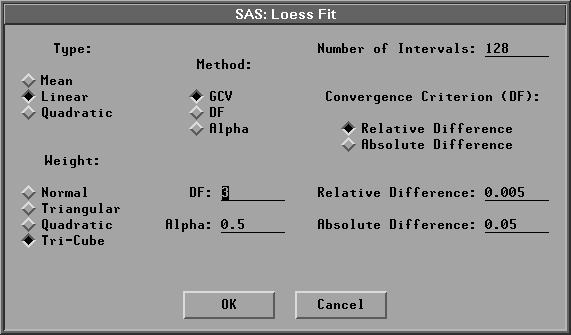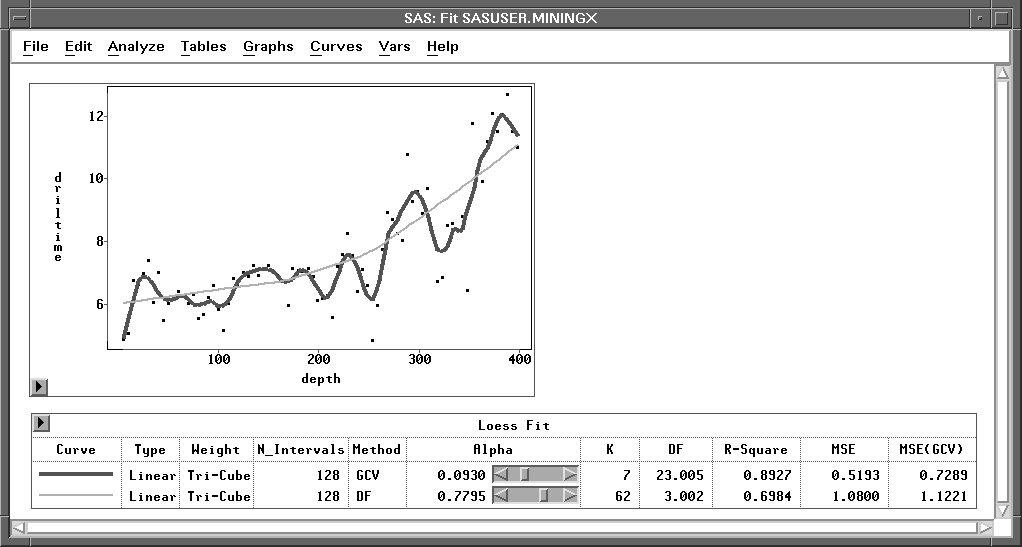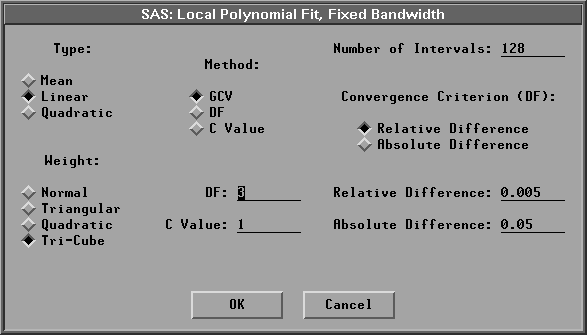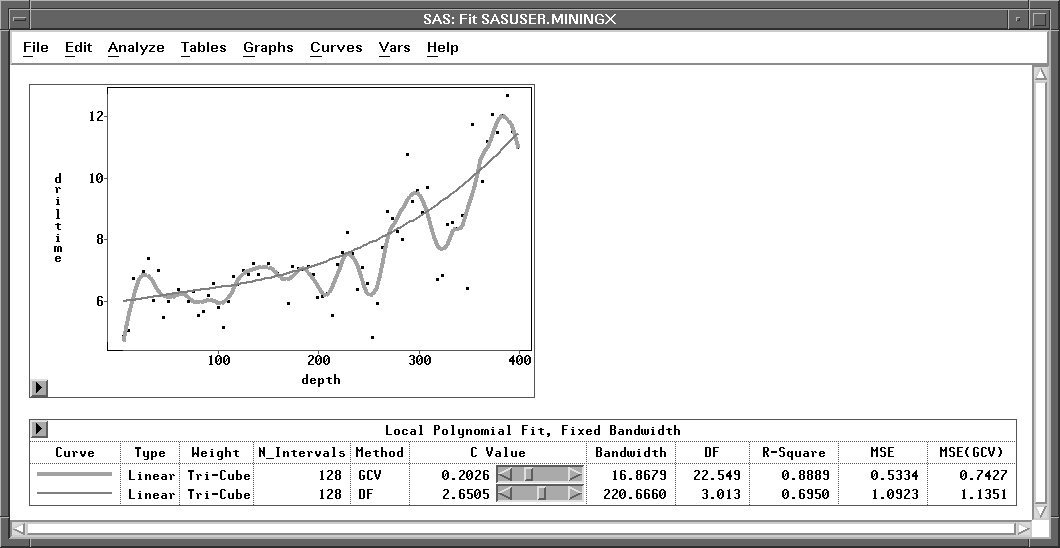| Fit Analyses |
Nonparametric Local Polynomial Smoother
The kernel estimator fits a local mean at each point x and thus cannot even estimate a line without bias (Cleveland, Cleveland, Devlin and Grosse 1988). An estimator based on locally-weighted regression lines or locally-weighted quadratic polynomials may give more satisfactory results.
A local polynomial smoother fits a locally-weighted regression at each point x to produce the estimate at x. Different types of regression and weight functions are used in the estimation.
SAS/INSIGHT software provides the following three types of regression:
| a locally-weighted mean | ||
| a locally-weighted regression line | ||
| a locally-weighted quadratic polynomial regression |
The weights are derived from a single function that is independent of the design
SAS/INSIGHT software uses the following weight functions:
Note |
The normal weight function is proportional to a truncated normal density function. |
SAS/INSIGHT software provides two methods to compute the local bandwidth ![]() .The loess estimator (Cleveland 1979; Cleveland, Devlin and Grosse 1988) evaluates
.The loess estimator (Cleveland 1979; Cleveland, Devlin and Grosse 1988) evaluates ![]() based on the furthest distance from k nearest neighbors. A fixed bandwidth local polynomial estimator uses a constant bandwidth
based on the furthest distance from k nearest neighbors. A fixed bandwidth local polynomial estimator uses a constant bandwidth ![]() at each xi.
at each xi.
For a loess estimator, you select k nearest neighbors by specifying a positive constant ![]() .For
.For ![]() , k is
, k is ![]() truncated to an integer, where n is the number of observations. For
truncated to an integer, where n is the number of observations. For ![]() , k is set to n.
, k is set to n.
The local bandwidth ![]() is then computed as
is then computed as
where d(k)( xi) is the furthest distance from xi to its k nearest neighbors.
Note |
For |
For a fixed bandwidth local polynomial estimator, you select a bandwidth ![]() by specifying c in the formula
by specifying c in the formula
Note |
A fixed bandwidth local mean estimator is equivalent to a kernel smoother. |
By default, SAS/INSIGHT software divides the range of the explanatory variable into 128 evenly spaced intervals, then it fits locally-weighted regressions on this grid. A small value of c or ![]() may give the local polynomial fit to the data points near the grid points only and may not apply to the remaining points.
may give the local polynomial fit to the data points near the grid points only and may not apply to the remaining points.
For a data point xi that lies between two grid points ![]() , the predicted value is the weighted average of the two predicted values at the two nearest grid points:
, the predicted value is the weighted average of the two predicted values at the two nearest grid points:
- dij = [(xi- xi[j])/(xi[j+1]- xi[j] )]
A similar algorithm is used to compute the degrees of freedom of a local polynomial estimate, ![]() = trace(
= trace(![]() ). The ith diagonal element of the matrix
). The ith diagonal element of the matrix ![]() is
is
- (1- dij) hi[j] + dij hi[j+1]
After choosing Curves:Loess from the menu, you specify a loess fit in the Loess Fit dialog.

Figure 39.44: Loess Fit Dialog
In the dialog, you can specify the number of intervals, the regression type, the weight function, and the method for choosing the smoothing parameter. The default Type:Linear uses a linear regression, Weight:Tri-Cube uses a tri-cube weight function, and Method:GCV uses an ![]() value that minimizes
value that minimizes ![]() .
.
Figure 39.45 illustrates loess estimates with Type=Linear, Weight=Tri-Cube, and ![]() values of 0.0930 (the GCV value) and 0.7795 (DF=3). Use the slider to change the
values of 0.0930 (the GCV value) and 0.7795 (DF=3). Use the slider to change the ![]() value of the loess fit.
value of the loess fit.

Figure 39.45: Loess Estimates
The loess degrees of freedom is a function of local bandwidth ![]() .For
.For ![]() ,
, ![]() is a step function of
is a step function of ![]() and thus the loess df is a step function of
and thus the loess df is a step function of ![]() .The convergence criterion applies only when the specified df is less than
.The convergence criterion applies only when the specified df is less than ![]() ,the loess df for
,the loess df for ![]() .When the specified df is greater than
.When the specified df is greater than ![]() , SAS/INSIGHT software uses the
, SAS/INSIGHT software uses the ![]() value that has its df closest to the specified df.
value that has its df closest to the specified df.
Similarly, you can choose Curves:Local Polynomial, Fixed Bandwidth from the menu to specify a fixed bandwidth local polynomial fit.

Figure 39.46: Fixed Bandwidth Local Polynomial Fit Dialog
Figure 39.47 illustrates fixed bandwidth local polynomial estimates with Type=Linear, Weight=Tri-Cube, and c values of 0.2026 (the GCV value) and 2.6505 (DF=3). Use the slider to change the c value of the local polynomial fit.

Figure 39.47: Fixed Bandwidth Local Polynomial Estimates
Copyright © 2007 by SAS Institute Inc., Cary, NC, USA. All rights reserved.